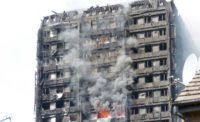More than four years after a fired raged through the 24-floor Grenfell Tower apartment building in London, causing 72 deaths, the government has told builders and developers they must fund and replace non-compliant cladding on buildings that are 11 to 18 meters tall—at an estimated cost of $5.5 billion.
By March, the industry must develop a plan to replace cladding on medium-rise buildings of the type that caused the Grenfell inferno or face government mandates. Taller buildings are covered by another government plan.
Housing Secretary Michael Gove urged developers and builders in a letter to agree to a funding and work program and to "provide comprehensive information on all buildings over 11 m which have historic fire-safety defects and which you have played a part in constructing in the last 30 years."
Companies that "caused the [fire] problem are dodging accountability and have made vast profits during the pandemic while hard working families have struggled," he noted.
One of the UK's largest residential builders, Persimmon plc., broadly welcomed Gove's plan. "We share the secretary of state's aspiration that leaseholders should not have to pay to remove cladding," it said. The company said it had already decided that leaseholders should not have to cover the cost of cladding removal.
But Rico Wojtulewicz, head of housing and planning policy for the National Federation of Builders, believes the government should "protect leaseholders by remediating works and then levy those costs back to those it finds did not meet regulation." Imposing a "tax" on industry "is disproportionate and will not alleviate the misery and unfair challenges for leaseholders quickly enough," he added..
Since the Grenfell fire in June 2017, the British press has been full of stories of leaseholders left facing huge bills to replace flammable cladding while being unable to sell their homes, which have been rendered worthless.
For the riskiest buildings, taller than 18 m, the government stepped up early last year, committing $4.8 billion to replace cladding. For buildings 11 to 18 m tall that are deemed to be at lower risk, the government's proposal, now abandoned, was for loans to leaseholders to cover remedial work.
By last October, work on 94% of 475 affected buildings in England that are more than 18 m tall had been completed or started, according to government data. Nearly half the non-compliant buildings were private residential, while eight were publicly owned.
But a focus on cladding removal alone is not enough, says the Building Engineering Services Association. “In many cases fire safety problems go well beyond cladding," said Graeme Fox, the group's technical chief. "Who will pay to fix those problems?” he asks.
While the flammable type of aluminium composite material cladding was known to be the main vector of rapid fire spread up the Grenfell Tower, serious procurement, design, materials, construction and monitoring faults have emerged as contributing factors in the ongoing public inquiry into the disaster.
Concluded in December 2018, the inquiry’s first phase focused on details of the fire that occurred at night. The current second phase, set to finish this summer, covers its causes.




Post a comment to this article
Report Abusive Comment